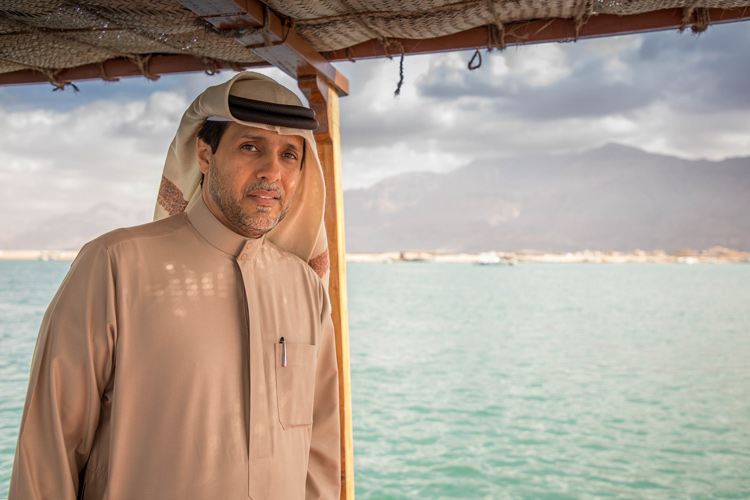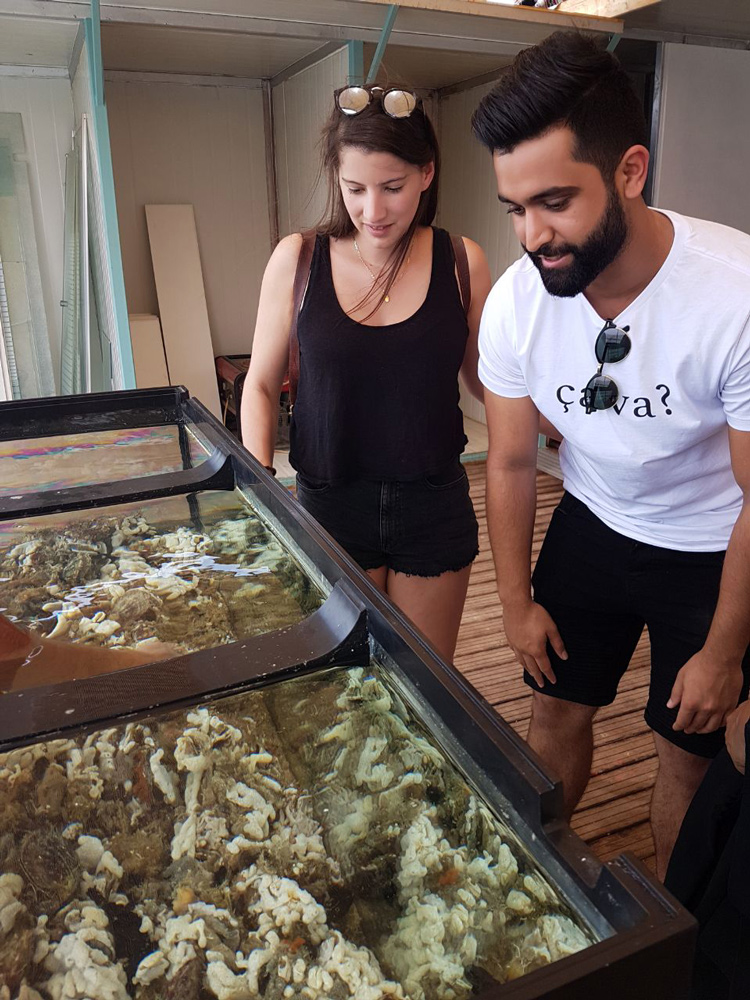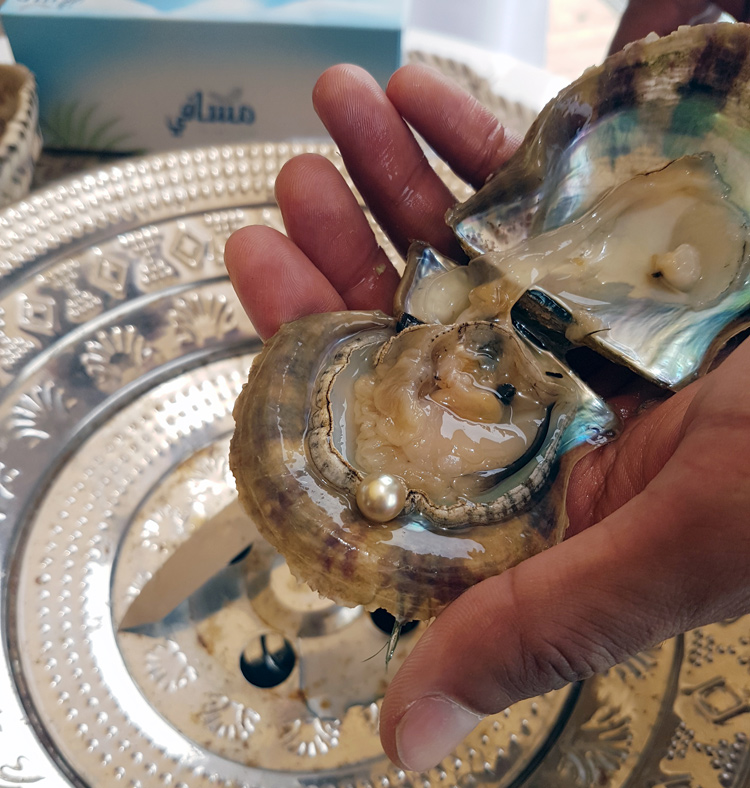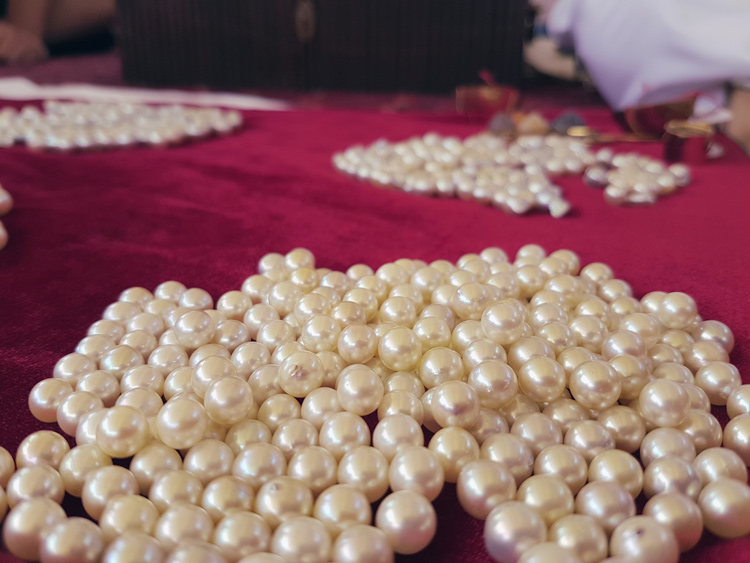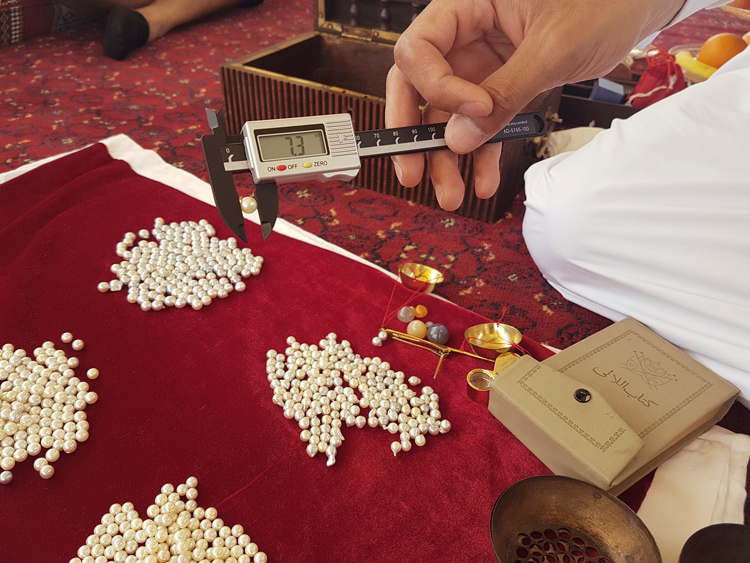Suwaidi Pearls is the UAE’s only pearl farm that provides locally sourced pearls to jewellers around the world that keeps this old age tradition alive in the region.
Hundreds of years before oil and tourism boosted the UAE’s economy it was pearls that kept the country alive, thanks to its pearl harvesting industry. With these natural stones becoming increasingly popular again it is surprising to know that pearls are being harvested locally on the shores of Ras Al Khaimah.
Abdulla Al Suwaidi is keeping the pearl industry alive with the regions only pearl farm; Suwaidi Pearls. Based in the small village of Al Rams at the foot of the Hajer mountains, Suwaidi Pearls was established in 2005 by Al Suwaidi. He has a heritage in pearl diving – his family were experts in the trade for centuries until pearl farming died out in the region.
Unlike gemstones, pearls are a unique entity. Natural pearls are found inside the shell of an oyster as a result of a small grain of sand finding its way in between the two shells. Over a period of time in order to protect itself from irritation, the oyster will quickly begin covering the sand with layers of nacre — the mineral substance that fashions the mollusk’s shells. Layer upon layer of nacre, also known as mother-of-pearl, coat the grain of sand until the iridescent gem is formed. This is a slow process and is hard to detect and rare to find. Many years ago pearl divers would physically search for pearls, in dangerous conditions, searching through hundreds of oysters before finding their treasures. Pearls can also be cultured. This is a process that involves pearl farmers embedding a grain of sand into a mollusk – this will likely eventually turn into a pearl. This method has a much higher success rate and allows a greater number of pearls to be harvested in a shorter period of time.
Cultured Arabian pearls are the most distinctive in terms of their size, quality and nacre thickness. They are not easy to harvest and require and intense process that has to be done in the most specific and demanding of environments. The lagoon at Al Rams benefits from the fresh rainwater that comes from the Hajer mountains and fills the seawater with oxygen, making it the perfect environment for the pearls to grown.
Suwaidi Pearls have already supplied pearls to Mouawad and Van Cleef & Arpels, as well as many local designers. But founder and pearl diver Abdulla Al Suwaidi has bigger plans for his business, with hopes to supply pearls to many of the world’s top jewellers. We chat to him on the past, present and future.
What makes these pearls so unique?
Our pearls are unique as they have been cultivated from the first Arabian Pearl farm in the world. This is a potential development that links the past to the future, a journey of the Natural Pearls to Cultured Pearls in the Gulf region. We have been in the cultured pearls business for almost a decade and have successfully cultured some of the finest types of pearls from the Arabian seas. I have successfully cultivated more than 100,000 cultured pearls in my farm in Al Rams, Ras Al Khaimah.
This oyster is susceptible to disease and torrent weather conditions so every pearl found is a miracle. Cultured pearls are not like synthetic gemstones, where neither the processes nor the environment are influenced by nature. Achieving high-grade pearls with a beautiful luster is very demanding and requires knowledge and a long-term vision that particularly focuses on sustainable and responsible best farming practices.
The discerning Arabian client will only accept the best. My vision of creating a thriving Gulf pearl industry that will be enjoyed by future generations is my raison d’etre. Buying a Suwaidi Pearl is therefore an investment, that not only is involved in the promotion of responsible relationships with our environment, but also in Arabian heritage.
My belief is not in just making or achieving something new from the pearls, but also complimenting them with continuous enchanted and adventurous endless stories of my ancestors relationships with the pearls
.
Centuries after centuries the beauty of the pearls were featured by my ancestors and it only paused by the end of 1920’s. However, just few decades ahead in 2005, I engineered and reinstated, repositioned and revived the Arabian pearls legacy back to where it belongs and where it shall remain and stay.
Why is pearling in this region something that is so close to your heart?
I think because of the hardships and survival instinct that was the core strength of the people of the pearls in the Gulf. The people had abundance of faith and passion that lead them to experience the joy of prosperity in the midst of harsh diversity. Many divers would journey for months and face all kinds of hardships such as marine hazards, sickness, hallucinations and dangerous encounters with venomous stings and bites of jellyfish, sharks, barracuda, and sawfish. They survived on dates, coffees, fish and oyster meats for months. However, they maintained high hopes and faith and entertained themselves with folklore songs and beautiful chants as their boats continued to navigate by the direction of the sun and the color and depth of the sea.
The women of Al Rams and neighboring villages would take on the role of taking care of the young and old and keeping themselves busy by taking over the men’s responsibilities and tasks. They would keep their homes safe and prepare the essence of musk, saffron and amber in preparation of welcoming home their fathers, brothers, husbands and sons. They would gather every evening chanting poets, singing songs of the pearls, seas and journeys of the divers! They would pray and yearn for the safe return of their loved ones. These divers brought hope of prosperity to their families. Such was the life of the divers and their families all around Al Rams and neighboring villages.
Tragedy was inevitable, however, the return home was always a joyful occasion. As they approached the shores of their homes, from a distance you would hear their chants in rhythm with the oars, looking forward to uniting with their loved ones and sharing the stories of their journeys. The blend of prosperity and adversity in the past has been kept of the memory of generation after a generation and so it has stayed in my heart.
Is pearl diving something that’s quite difficult to learn?
Not at all, you must have what I call the 3 P’s (Passion, Persistence, and Patience).
Talk us through the process of developing pearls in the ocean.
It’s a bit complicated due to the nature of the environment and the species, but it can be simply explain in six steps:
We breed our own natural oysters in the farm (3-6 months),
Preparing our adult oysters for the seeding operation (6 months),
Seeding operation of our oysters daily basis,
Monitoring the oysters after operation (30 days),
Caring and nurturing the seeded oysters for about a year while nacre grows over the seeded nucleus,
Harvesting the pearls!
How has this process changed from hundreds of years ago?
Pearl diving in the past was a very hard process, gathering hundreds of thousands of oysters to get 1% pearls. It was known out of 1000 natural oysters collected from the sea by a diver, the possibility of finding a pearl is 1%, which means 10 Pearls.
However, in our current process, for every 1000 seeded Oysters, there is 60% rate of finding pearls and these are of different grades, quality, luster, size and colors etc. giving us 600 pearls out of 1000 harvested oysters.
What about extracting the pearls from the mollusks – is this a complicated process?
The process is very simple, and it takes few seconds. A special traditional knife is used to open the oyster to extract the pearl from its gonad, similar to the extracting of a natural pearl from an oyster.
How long does it take to harvest a pearl?
One year after the seeding process.
Tell us about the difference in colours of pearls.
Our Arabian pearl oyster have the same DNA of famous and unique Arabian natural pearls, it produces 13 different color from the glowing white, off white, to the shades of blues, greys, yellowish, gold, pinkish, violet and green colors.
This is something that has been in your family for centuries – how are you keeping the memory of your ancestors alive?
My family, is intrinsically linked to the history of the pearling era in the Gulf, dating back to 12th & 13th century & belonging to the Julfar dynasty. Pearling was embedded in the culture and the traditions of everyday life of the Julfar villages, the birth place of my ancestors. The family background traces back to life in the Gulf region that has been entwined with the jewel of the ocean for over 7000 years. My ancestors carried on with pearling for generations leading finally to the 20th century with my grandfather Mohammed Bin Abdulla Al-Suwaidi being one of the last remaining pearl divers of Al Suwaidi legacy. For centuries many divers dedicated their lives to pearl diving as it was the main means of living and generating wealth.
I have a symbolic relationship with pearls and for me pearls symbolise wisdom and I believe this organic gem is the subject of many myths and legends. I believe pearls are the mystical treasure of the earth and represent purity, generosity, integrity and loyalty of the people who have them. Therefore the history and legacy of my ancestors and their intimate relationship with the pearls has inspired me and made me who I am, whilst my high esteem for these oceanic gems has driven me to secure their heritage and future.
Why is this particular location good for harvesting pearls?
The environment plays a fundamental role in the growth of the pearls. The lagoon in Al Rams benefits from the fresh rainwater that comes from the surrounding mountains and fills the seawater reducing the salinity and infusing oxygen. This natural occurrence increases the capacity of oysters to produce more nacre, the material that grows in layers to form the pearl. Cultured pearls are still a product of nature, they are grown naturally and require the same biological processes. There must be a healthy oyster in an unpolluted environment to produce a beautiful pearl.
Is it difficult to harvest pearls during the summer when there isn’t much rain?
We stop seeding operations during the summer months but we maintain all monitoring and maintenance work and this actually goes on through out the year ensuring clean environment for oysters and other marine life.
Tell us about some of the jewelers you are now supplying pearls to?
Suwaidi Pearls have adorned some of the collections of international brands such Steven Webster, Sara Ho, Van Cleef & Arpels and Mouawad. As well as customised private collections for some members of the royal family in the region. We also work with some of the young Emirati women’s jewellery designers who have created beautiful jewels from our pearls.
What about the people that work for you – how do they learn to pearl dive?
I have few staff working on the farm that I personally trained to Pearl dive. Pearl diving is all about technique, practice and passion.
How do you think pearls are perceived around the world?
Pearls are one, if not the only gem produced by a living species. Hence it is considered mystical, spiritual and lucky! They are largely worn by royalties and also women who are passionate about pearls. Arabian pearls are specific and have their own long lasting reputation of perfection and exquisiteness.
What’s the one piece of jewellery every woman should own?
A string of pearls.
What is your vision for the future of the company?
My vision is to launch a global brand that would boast pearls of the finest quality from the DNA of the Arabian pearls. I invented a new enhanced modern technique for the first time in the history of cultured pearls that will cultivate much higher quality of Pearls.
These pearls will be routed to some of the best well known Jewelry designers in the world. I have several initiatives with the government and private sector to re-establish the UAE as an important hub for not only trading but also producing pearls. Pearl farming is a long-term investment; there must be the correct balance between a protected environment, in which eco-systems co-exist, and a successfully operating pearl farm that can give the time needed for the nacre to build to produce high-grade pearls.
Today, this beauty, as well as the complex creation of pearls, still intrigues and excites; this is particularly true for my determination to grow and protect the legacy of Arabian pearls for future generations. It’s this pearl legacy that my grandfather Mohammed, passed over to me without saying a word… Hence I became the ultimate guardian of the pearls.


